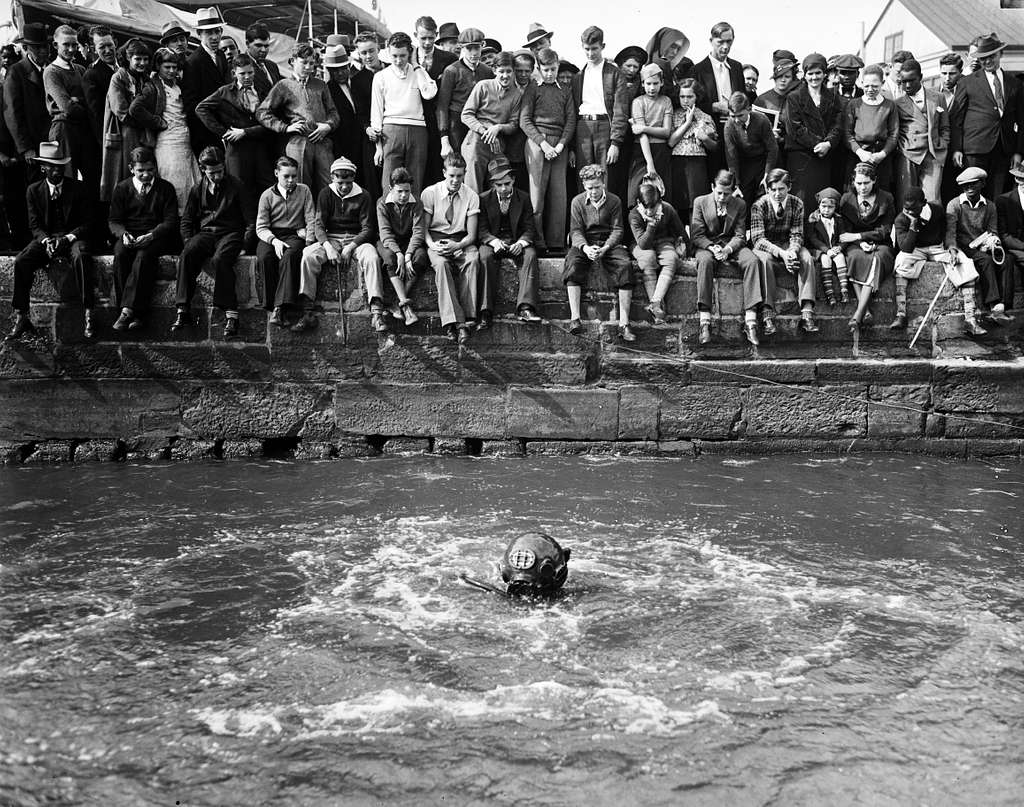
A deep-sea diver puts on a show for Navy Day, October 27, 1935, at the Washington Navy Yard, Washington, D.C., where there was a dive school then. (Photo courtesy Library of Congress)
It can be confusing to civilians that the branches of the U.S. military (Army, Navy, Marine Corps, Air Force, Coast Guard, and now Space Force) have different but often overlapping missions. Branches often train together in the field and cross-train in each other’s schools. I served in the Army, for example, but went to dive school at the U.S. Navy’s Naval Diving and Salvage Training Center in Panama City, Florida. In an earlier era, the military’s combined-services dive school was at the Washington Navy Yard. Last weekend I finally got the chance to visit.
The Navy Yard, the “oldest shore establishment” of our navy, is still an active military facility and the residence of the Chief of Naval Operations, Admiral Lisa Franchetti, the highest-ranking officer in the navy. It is also home to “Naval Sea Systems Command, Naval Reactors, Naval Facilities Engineering Command, U.S. Naval Judge Advocate General’s Corps…the U.S. Navy Band…the Naval History and Heritage Command, the National Museum of the U.S. Navy, and the Cold War Gallery.”
All this activity goes on, surprisingly, just two miles southeast of the U.S. Capitol, on a bend of the Anacostia River, where larger boat traffic is now restricted, ironically, by the Frederick Douglass Memorial Bridge, the 11th Street Bridge, and the Navy Yard Bridge. Our Uber driver, who had never been there before, pulled up to the forbidding-looking, guarded gate and insisted a little hysterically that we get out of his car. A young Marine veteran and docent at the National Museum of the United States Navy had to walk from the museum to the gate to escort us onto the facility.
Any trace of the old dive school is gone, but the museum has an undersea exhibit with some gear, an articulated suit, a mockup of the submersible Alvin, and the real bathyscaphe Trieste, the first crewed vessel to reach the deepest point in the earth’s oceans. The museum is beginning to draw down its artifacts in preparation for a move to a new building just outside the Navy Yard, if all goes to plan, but there is still plenty to see. Docents such as Mike, the young Marine, are extremely well-versed in exhibits about actions, ships, people, and other historical objects and buildings on the grounds.
To my surprise the Yard was a gun foundry for much of its existence. Lincoln frequented the Yard as president during the Civil War, and he inspected the ironclad USS Montauk there before he went to Ford’s Theatre that night. John Wilkes Booth escaped over the Navy Yard Bridge a few hours later; his co-conspirators were held aboard the Montauk a few days later; and Booth’s body was eventually autopsied on the ship. Though Washington can feel dull and flat, all you have to do is press, and the layers of history become visible.
Despite some overlaps, military branches do in the end have their own histories, traditions, and, in particular, things, which set an emotional tone. Marines are “Leathernecks” for their stiff collars, originally meant to prevent cutlass wounds. Sailors were “swabbies” for their mops, or “tars” for the tar used on old ships. Navy cadre at the dive school called us “trees” for our camouflage-patterned army uniforms.
I never considered enlisting in the Navy. I like ships for their functional beauty and what they can do, I like to watch movies with ships in them, and I might have loved being a naval architect, but the thought of living on one has always depressed me. (I think of Italo Calvino’s lonely image “of docks, of women at the windows,” in Invisible Cities.) In dive school, I got so seasick on an old minesweeper caught in a gale that I fed all the fish in the Gulf of Mexico. I dragged myself to the master chief running the side and begged him to let me find a rack and try to sleep it off. Some of the sailors were already down there.
“Get your ass back to work, Tree,” he said and laughed.
It made for an enjoyable afternoon, standing firmly in Building 76 on the Navy Yard last weekend, reading about the navy’s ships (as well as their airplanes, dirigibles, submersibles, weaponry, and characters), remembering my time, and thinking about how things overlap.
National Museum of the US Navy is accessed at the gate at 11th and O Streets (1022 O Street SE, Washington, DC). It is currently open only on Saturdays from 10 am to 4 pm. Call ahead for an escort if you do not have a military ID card: 202-685-0589.
